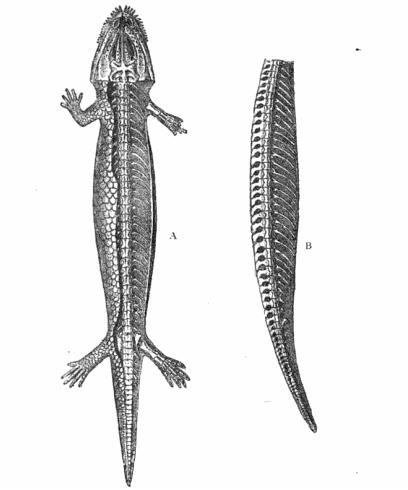Hyloplesion on:
[Wikipedia]
[Google]
[Amazon]
''Hyloplesion'' is an extinct
 ''Hyloplesion'' was about as large as a medium-sized
''Hyloplesion'' was about as large as a medium-sized
''Hyloplesion''
in the
genus
Genus ( plural genera ) is a taxonomic rank used in the biological classification of living and fossil organisms as well as viruses. In the hierarchy of biological classification, genus comes above species and below family. In binomial nom ...
of microbrachomorph microsaur
Microsauria ("small lizards") is an extinct, possibly polyphyletic order of tetrapods from the late Carboniferous and early Permian periods. It is the most diverse and species-rich group of lepospondyls. Recently, Microsauria has been consider ...
. It is the type and only genus within the family Hyloplesiontidae. Fossils have been found from the Czech Republic
The Czech Republic, or simply Czechia, is a landlocked country in Central Europe. Historically known as Bohemia, it is bordered by Austria to the south, Germany to the west, Poland to the northeast, and Slovakia to the southeast. The ...
near the towns of Plzeň, Nýřany, and Třemošná, and date back to the Middle Pennsylvanian. The type species
In zoological nomenclature, a type species (''species typica'') is the species name with which the name of a genus or subgenus is considered to be permanently taxonomically associated, i.e., the species that contains the biological type specime ...
is ''H. longicostatum'', named in 1883. Two species belonging to different genera, ''Seeleya pusilla'' and ''Orthocosta microscopica'', have been synonymized with ''H. longicostatum'' and are thought to represent very immature individuals.
Description
 ''Hyloplesion'' was about as large as a medium-sized
''Hyloplesion'' was about as large as a medium-sized salamander
Salamanders are a group of amphibians typically characterized by their lizard-like appearance, with slender bodies, blunt snouts, short limbs projecting at right angles to the body, and the presence of a tail in both larvae and adults. All t ...
, with the length of known specimens ranging from 17-77mm.
The skull is triangular in shape. Unlike many other microsaurs, the palate of ''Hyloplesion'' contains large vacuities, or openings. The fifth maxilla
The maxilla (plural: ''maxillae'' ) in vertebrates is the upper fixed (not fixed in Neopterygii) bone of the jaw formed from the fusion of two maxillary bones. In humans, the upper jaw includes the hard palate in the front of the mouth. T ...
ry tooth is enlarged and resembles a canine. The skull of ''Hyloplesion'' superficially resembles that of the unrelated romeriid reptile ''Romeria
Christianity has a strong tradition of pilgrimages, both to sites relevant to the New Testament narrative (especially in the Holy Land) and to sites associated with later saints or miracles.
History
Christian pilgrimages were first made to si ...
'' in lateral view due to similarities in the pattern of the dermal bones and the hooked shape of the premaxilla
The premaxilla (or praemaxilla) is one of a pair of small cranial bones at the very tip of the upper jaw of many animals, usually, but not always, bearing teeth. In humans, they are fused with the maxilla. The "premaxilla" of therian mammal has ...
. However, the skull differs from that of ''Romeria'' in dorsal view, as the parietals are much wider in ''Hyloplesion''.
The atlas
An atlas is a collection of maps; it is typically a bundle of maps of Earth or of a region of Earth.
Atlases have traditionally been bound into book form, but today many atlases are in multimedia formats. In addition to presenting geograp ...
arch also resembles those of romeriids and, unlike other microsaurs, is unswollen. The trunk is elongate, with thin ribs extending from each vertebra. The presence of a large scapulocoracoid The scapulocoracoid is the unit of the pectoral girdle that contains the coracoid and scapula.
The coracoid itself is a beak-shaped bone that is commonly found in most vertebrates with a few exceptions.
The scapula is commonly known as the ''shoulde ...
in ''Hyloplesion'' distinguishes it from ''Microbrachis''. The limb bones are small and robust, with the hindlimbs being quite larger than the forelimbs . Like other microbrachomorphs such as '' Microbrachis'', ''Hyloplesion'' has only three digits in the manus, a condition known as tridactyly.
Paleobiology
A range of morphological characteristics makes it difficult to determine whether ''Hyloplesion'' was primarily terrestrial or aquatic. Although the digits are well ossified, the reduced number of toes in ''Hyloplesion'' is seen as an adaptation for an aquatic lifestyle. There is no evidence for lateral-line canals in the skull, although they were most likely present, separated from the skull by a layer of connective tissue.References
External links
''Hyloplesion''
in the
Paleobiology Database
The Paleobiology Database is an online resource for information on the distribution and classification of fossil animals, plants, and microorganisms.
History
The Paleobiology Database (PBDB) originated in the NCEAS-funded Phanerozoic Marine Pale ...
Microsauria
Carboniferous amphibians of Europe
Prehistoric amphibian genera
Taxa named by Antonin Fritsch
{{carboniferous-animal-stub